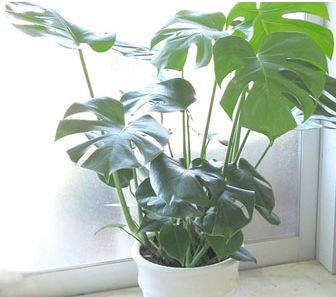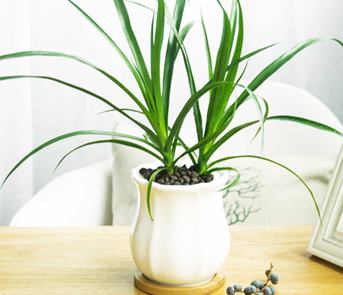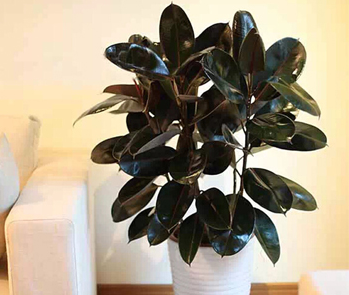Is the tortoise back bamboo poisonous? what are the methods of reproduction and pruning?
Speaking of this tortoise back bamboo, this is a lot of people like to raise, the leaves are bright green, let's see if the tortoise back bamboo is poisonous? What are the breeding and pruning methods of tortoise-backed bamboo:

Is the tortoise carrying bamboo poisonous?
Tortoise back bamboo is slightly toxic, mainly by the root to absorb water, when the temperature is low, water droplets will condense on the leaves. Some children see, will feel very cute, pick it to play, if not careful bite, may be poisoned. However, the toxicity of tortoise back bamboo is not serious, as long as you pay attention not to eat its juice or knead it into your eyes, it generally will not have an adverse effect on people.
Planting tortoise back bamboo at home, in addition to selecting a good variety, but also pay attention to the location, try not to put in the children's room, because the child is naughty, may pick its leaves, in order to avoid poisoning, the location must be selected.
The breeding method of tortoise-backed bamboo:
Cutting: in spring and summer, the temperature is moderate, and the survival rate of tortoise back bamboo is high by using stem node cutting. First of all, select 20-25 cm side branches as cuttings, cut off most of the leaves, leaving only the upper leaflets, and then insert into the mixed medium. When selecting lateral branches, we should pay attention to the need for full stem tissue, robust growth, and not too many axillary buds. In order to accelerate the rooting of lateral branches, it is necessary to retain short leaves to absorb water, strengthen fertilizer and water management and control room temperature. If you need to hang embellishment, you can prepare a wooden frame, put on the fertile rotten leaf soil, and plant the bamboo on the back of the turtle that takes root and survives.
Ramet: in summer and autumn, the stem top and axillary buds of Phyllostachys pubescens were directly planted in a barrel, and 10 mg / L 6-benzylaminoadenine was used as substrate in MS medium. The axillary buds will take root after 6 weeks, and the survival rate is very high, and the molding effect is good. In addition, the side branches of large tortoise back bamboo can also be used as cuttings directly planted in the bowl, watering and fertilizing to slowly induce it to take root.
The pruning method of tortoise back bamboo:
When the growth of the leaves of tortoise back bamboo is too dense and the overall aesthetics is affected, the leaves should be trimmed. Do not use scissors directly to trim the leaves, because cutting the leaves with scissors will cause the wound to be squeezed in water, which makes it difficult to heal in the later stage. In addition, the tortoise back bamboo has only one growing point, so remember not to damage the growing point when picking leaves, unless there is a bud bag on a main stem, which can grow shoots after culture.
To trim the tortoise back bamboo, first remove part of its upper leaves, and then trim the side leaves according to the needs of the overall shape. After pruning, it should be watered and fertilized regularly to make it grow again. If the overall shape is not affected, do not trim too many times a year, it is recommended to trim once a year.
Tortoise-backed bamboo is slightly toxic, so it is necessary to put it out of sight of children. The pruning and breeding methods of tortoise-backed bamboo are introduced here, so hurry up to plant a few plants in your own home.
The feeding method of tortoise back bamboo
The leaves of the tortoise back bamboo are very strange, but the plant shape of the tortoise back bamboo is beautiful, and the overall ornamental effect is very good, so it is a very well-known indoor foliage plant. But not all foliage plants can be raised indoors. The editor will analyze for you whether tortoise back bamboo can be raised indoors, and how to raise it well.
Tortoise back bamboo
The young leaves of Phyllostachys pubescens are heart-shaped, without holes, and become widely ovoid when they grow up. There are oval perforations between the veins, and the leaves are long-stalked and dark green. Buddha flame inflorescence, Buddha flame boat-shaped, November flowering, yellowish. Tortoise back bamboo, also known as "Penglai banana" and "Penglai banana", is an evergreen climbing foliage plant of Araceae. The stem is covered with brown air roots, shaped like electric wires, so the leaves are oval, and many oblong holes and deep cracks are scattered in the pinnate veins. Its shape is similar to the tortoise shell pattern, and the stem has nodes like bamboo stems, so it is called "tortoise back bamboo".
First, whether the tortoise back bamboo is suitable to be raised indoors.
Through consulting the data, we know that the tortoise back bamboo is a poisonous plant included in the Chinese plant atlas database, and its toxicity is that the juice has the effect of irritation and corrosion, and the skin contact causes pain and burn. The immature pulp calcium oxalate needle crystal burns the tongue when eaten. Thus it can be seen that the tortoise back bamboo is a poisonous plant, and its toxicity is much milder than that of the same genus Di Shui Guanyin. The toxicity of Phyllostachys pubescens is mainly through deep contact and consumption, as long as the juice is not rubbed into the eyes or wounds, the toxicity will not cause harm to human beings.
Moreover, the tortoise back bamboo is not included in the 52 cancer-promoting plants, it will not release harmful gases, harmful to everyone's health. On the contrary, the tortoise back bamboo is a natural scavenger, which can remove harmful substances from the air and purify the air. Some experiments have shown that the tortoise-backed bamboo can remove 80% of the harmful gases in the air, which is very suitable for the newly decorated home.
In addition, the tortoise back bamboo has a peculiar ability to absorb carbon dioxide at night. It contains many organic acids, which can react with the carbon dioxide absorbed at night and become another organic acid. During the day, this changed organic acid is reduced to the original organic acid, and the carbon dioxide is decomposed for photosynthesis. Tortoise-backed bamboo will not compete with everyone for oxygen at night, and it will also remove carbon dioxide released by human breathing, keep the indoor air fresh and help people sleep.
Tortoise back bamboo
Second, the culture method of tortoise back bamboo
1. Soil: tortoise back bamboo likes loose and well drained soil, which can be prepared with garden soil, river sand and rotten leaf soil.
2, sunshine: tortoise back bamboo is more shady, avoid the scorching sun, like scattered light, should avoid direct strong light. If the sun is too strong, the leaves will be burned; if the light is too dark, the color of the leaves will fade. The flowerpot can be placed in the north window in summer, and the windowsill facing south should be put in sufficient sunshine in winter.
3. Temperature: the tortoise back bamboo likes to be warm, and the suitable temperature for growth is 15 ℃ 25 min. In winter, indoor overwintering should not be less than 5 ℃.
4. Moisture: the tortoise back bamboo likes to be wet, and the basin soil is dry but not cracked, moist but not wet. The air humidity should be 60%. The leaves should be sprayed and watered every day in summer to keep the leaves bright. Do not spray water to the leaves in winter, otherwise the leaves will appear black spots, or even black and rotten.
5. Fertilization: the peak growth period is from April to September, and rarefied liquid fertilizer is applied once every half a month. During the growth period, 28% or 37% liquid nitrogen fertilizer was irrigated once in about 2 weeks to make the plant strong. Increase the application of phosphorus and potassium fertilizer after autumn to make the stem stout and prevent lodging.
6. Pruning: when the leaves of the stem nodes grow too dense and the branches grow too long, pay attention to pruning the whole plant and strive for natural beauty. If you want to make the stem grow tall quickly, you can trim the lower aging leaves moderately.
7. pest control: the main diseases and insect pests that harm the bamboo are shell insects and gray spot disease, which can be sprayed with 1000 times of omethoate emulsion. When gray spot disease occurs, it is necessary to strengthen plant maintenance, remove insects in time, cut off some diseased leaves, and spray with 1000 times of topiramate or 0.5% Bordeaux solution.
Although the tortoise back bamboo has a certain toxicity, but the toxicity of the tortoise back bamboo will not cause air pollution, so it is more suitable for indoor foliage plants. But the editor would like to remind all friends that families with children and pets must be careful not to eat by mistake, otherwise it will cause poisoning.
Culture methods and matters needing attention of tortoise back bamboo
Tortoise-backed bamboo is a vine ornamental plant derived from the tropical rainforest of Mexico. Its shape is simple and evergreen, so it is deeply loved by everyone. So what are the breeding methods and matters needing attention of tortoise back bamboo? Let's take a closer look at it.
Pictures of tortoise-backed bamboo
First, the culture method of tortoise back bamboo (is the tortoise back bamboo poisonous? can it be kept indoors)
(1) soil
Cuttings of tortoise back bamboo take root, and fertile pond mud or black mud can be used when transplanting into the pot. Because of its rapid growth, the basin needs to be changed every year. The time to change the basin should be between March and April. When changing the basin, remove some of the old soil and withered roots and replace it with a larger basin. Put some hooves and broken bones at the bottom of the basin as base fertilizer and fill them with a mixture of rotten leaf soil, vegetable garden soil and sand soil.
Pictures of tortoise-backed bamboo
(2) Light and temperature
Tortoise back bamboo is a typical shade-tolerant plant, large-scale production must be equipped with shading facilities, can use 50% shading net, especially sowing seedlings and just cutting into live seedlings, avoid direct sunlight, so as to avoid leaf burns. The molded plants should also pay attention to shading in the middle of summer, otherwise the leaves will age and lack of natural luster, which will affect the ornamental value. Midsummer should be placed indoors or under the shade, not on the balcony where the sun is too strong, otherwise, it is easy to cause dead leaves. When the winter temperature drops to 6 ℃, it should be moved into the room to keep warm to prevent the cold wind from blowing, otherwise the leaves are easy to wither and yellow and fall off.
Pictures of tortoise-backed bamboo
(3) Water and fertilizer
Tortoise back bamboo likes to be moist and needs plenty of water during its growth. Daily watering can be once a day, one in the morning and one in the evening in summer. when the weather is dry, it is more necessary to spray water to the leaves and spray water to the maintenance environment to keep the air and leaves bright. Water once every 3-4 days in winter. Spray the leaves with water close to room temperature every 7-10 days to keep the plant evergreen and fresh and improve the ornamental value. Tortoise back bamboo is a more fertilizer-loving flower. From April to September, thin pancake fertilizer and water can be applied every 15 days; it can also be applied thinly with retted human urine and water. At the same time, the root of tortoise back bamboo is relatively tender, do not apply raw fertilizer and thick fertilizer, so as not to burn roots. It is best to use "Huiyou" 20-8-20 with high potassium nitrate fertilizer and 20-20-20 general fertilizer in the four seasons, which is more beneficial to the growth of tortoise back bamboo.
Pictures of tortoise-backed bamboo
(4) growth habits
Tortoise-backed bamboos are often attached to tall trees in tropical rain forests. Like warm and humid environment, avoid strong light exposure and drying, shade-resistant, easy to grow in fertile and loose, large water absorption, good water retention of slightly acidic loam, rotten leaf soil or peat soil is the best. The suitable temperature for growth was 20-25 ℃, and freezing injury was easy to occur when the temperature was lower than 5 ℃. When the temperature rose above 32 ℃, the growth stopped.
Pictures of tortoise-backed bamboo
Second, points for attention of tortoise back bamboo
(1) watering
Because the leaves are relatively large, resulting in the rapid loss of water, so we should often water, keep the soil moist, must not be too waterlogged and rotten roots, in summer, spray water on its leaves 3-5 times a day, so as not to cause branches and leaves not to grow. It is reasonable to control the amount of water, irrigate more water in dry hot days and prosperous periods, and water as little as possible in winter and seedlings.
Pictures of tortoise-backed bamboo
(2) fertilization
The growth of tortoise back bamboo needs sufficient fertilizer. In the peak period of growth, fertilizer is applied about once every two weeks. The amount of fertilizer should be controlled to maintain its beauty.
Pictures of tortoise-backed bamboo
(3) change the basin
It changes the basin once a year from March to April. Of course, those outside have to be moved indoors. You can choose early October. In the process of changing the basin, you should first replace the old soil, trim the root of the trimmer, cut off the withered part, and then add appropriate organic fertilizer.
Pictures of tortoise-backed bamboo
(4) Diseases and insect pests
The diseases generally include stem blight, leaf spots, gray spots and other diseases, and there are often diseases of shell insects, which usually need to be prevented and treated with an old toothbrush and then sprayed with 1000 times of omethoate.
- Prev

Can the sword leaf dragon blood tree be kept indoors? can it be hydroponically cultured?
To talk about this sword leaf dragon blood tree, there are still many people like, the long leaves are green all the year round, let's see if the sword leaf dragon blood tree can be kept indoors. Can the sword leaf dragon blood tree be hydroponically cultured: can the sword leaf dragon blood tree be raised indoors: the sword leaf dragon blood tree can also be put indoors
- Next

How long does it take to water the leaves of a rubber tree?
Rubber tree, is a super magic, many people like, looking at this green shining plant, the mood is much better, to see how the rubber tree leaves? How long does the rubber tree water: how do the rubber trees lose their leaves: reason 1: there is not enough light for the rubber tree to enjoy the sun, if it is left in the shade for a long time.
Related
- Fuxing push coffee new agricultural production and marketing class: lack of small-scale processing plants
- Jujube rice field leisure farm deep ploughing Yilan for five years to create a space for organic food and play
- Nongyu Farm-A trial of organic papaya for brave women with advanced technology
- Four points for attention in the prevention and control of diseases and insect pests of edible fungi
- How to add nutrient solution to Edible Fungi
- Is there any good way to control edible fungus mites?
- Open Inoculation Technology of Edible Fungi
- Is there any clever way to use fertilizer for edible fungus in winter?
- What agents are used to kill the pathogens of edible fungi in the mushroom shed?
- Rapid drying of Edible Fungi

